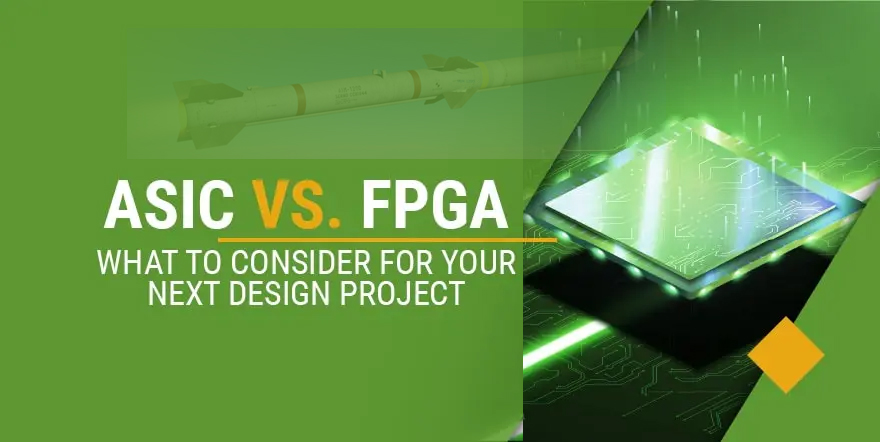Time: 2025-04-22 14:11:51View:
The choice between FPGA (Field-Programmable Gate Array) and ASIC (Application-Specific Integrated Circuit) solutions in missile systems depends on factors like performance, flexibility, power efficiency, cost, and development time. Below is a detailed comparison:

| FPGA | ASIC |
|---|---|
| ✔ High-speed parallel processing (good for real-time signal processing). | ✔ Ultra-high performance (optimized for specific tasks, lower latency). |
| ✖ Clock speeds typically lower than ASICs (due to programmable fabric overhead). | ✔ Can achieve GHz+ speeds with custom silicon. |
| ✔ Reconfigurable for algorithm updates (e.g., radar signal processing). | ✖ Fixed functionality (cannot be modified after fabrication). |
Winner: ASIC for raw speed, FPGA for adaptable high-speed processing.
| FPGA | ASIC |
|---|---|
| ✔ Reconfigurable in-field (critical for adaptive missile guidance). | ✖ Permanently fixed logic (no post-production changes). |
| ✔ Supports real-time algorithm updates (e.g., countermeasures against jamming). | ✖ Requires a new chip design for upgrades (costly & slow). |
Winner: FPGA (superior for evolving threat environments).
| FPGA | ASIC |
|---|---|
| ✖ Higher power consumption (programmable logic uses more energy). | ✔ Extremely power-efficient (optimized circuitry, no wasted logic). |
| ✔ Better than GPUs/CPUs for parallel tasks. | ✔ Ideal for long-endurance missiles (e.g., cruise missiles). |
Winner: ASIC (best for battery/size-constrained systems).
| FPGA | ASIC |
|---|---|
| ✔ Lower upfront cost (no fabrication needed). | ✖ High NRE (Non-Recurring Engineering) costs (~$1M+ for tape-out). |
| ✔ Faster development (weeks/months). | ✖ Long lead time (12–24 months for design, testing, fabrication). |
| ✔ Ideal for low-to-medium volume production. | ✔ Cheaper per unit at high volumes (e.g., mass-produced missiles). |
Winner:
FPGA for prototyping/low-volume.
ASIC for high-volume production.
| FPGA | ASIC |
|---|---|
| ✔ Radiation-tolerant FPGAs exist (e.g., Xilinx Kintex UltraScale+). | ✔ Inherently more reliable (no configuration memory to corrupt). |
| ✖ Susceptible to single-event upsets (SEUs) in space/high-altitude. | ✔ Can be hardened for extreme environments (nuclear, space). |
Winner: ASIC for mission-critical reliability.
| FPGA Applications | ASIC Applications |
|---|---|
| ▶ Guidance systems (adaptive radar processing). | ▶ Seeker heads (fixed-function signal processing). |
| ▶ Electronic warfare (reconfigurable jamming). | ▶ Flight control ICs (hardwired PID controllers). |
| ▶ Prototyping before ASIC tape-out. | ▶ Mass-produced missiles (Tomahawk, AMRAAM). |
| Factor | FPGA | ASIC | Best for Missiles? |
|---|---|---|---|
| Speed | Medium | High | ASIC (for seeker heads) |
| Flexibility | High | None | FPGA (EW/updates) |
| Power Use | Higher | Lowest | ASIC (long-range) |
| Unit Cost | $$ | $ (high volume) | ASIC (mass production) |
| Development | Fast | Slow | FPGA (rapid upgrades) |
| Reliability | Good | Best | ASIC (nuclear-hardened) |
Use FPGAs when:
The missile requires field-upgradable logic (e.g., counter-drone systems).
Development time is critical (e.g., prototype phase).
Low-to-medium volume production is needed.
Use ASICs when:
Performance/power efficiency is paramount (e.g., hypersonic missiles).
Mass production is planned (unit cost drops significantly).
Extreme reliability is required (e.g., nuclear scenarios).
Example Trade-Off:
The Raytheon AIM-120 AMRAAM uses ASICs for its radar seeker (fixed algorithms, high volume).
The AGM-88 HARM uses FPGAs for adaptable anti-radiation targeting.
Here’s a deeper technical dive into how FPGAs and ASICs are implemented in real-world missile systems, with concrete examples and architectural insights:
Function: Real-time Doppler radar processing for target tracking.
ASIC Advantage:
Custom-designed FFT (Fast Fourier Transform) hardware accelerators.
Ultra-low latency (~nanoseconds) for high-speed threat rejection.
Radiation-hardened for nuclear environments (e.g., BAE Systems RH ASICs).
Why Not FPGA?
Fixed algorithms don’t need reconfigurability.
ASIC power efficiency extends battery life in the terminal phase.
Function: Adaptive Electronic Counter-Countermeasures (ECCM).
FPGA Advantage:
Xilinx Ultrascale+ FPGA dynamically updates jamming profiles.
Machine learning models (e.g., CNN for threat classification) can be reloaded mid-flight.
Trade-Off:
10–20% higher power consumption vs. ASIC, but critical for evasion.
Function: Fin actuator control with hard real-time response (<1μs latency).
ASIC Implementation:
Dedicated PID control loops in silicon.
No configuration memory to corrupt (immune to cosmic rays).
FPGA Limitation:
Control loops in FPGAs risk single-event upsets (SEUs) at high altitudes.
Function: Data fusion (IR + radar + datalink) for mid-course updates.
FPGA Implementation:
Intel (Altera) Stratix 10 processes multi-sensor inputs in parallel.
Firmware can be patched to integrate new threat databases.
Function: DRFM (Digital RF Memory) for jamming enemy radars.
FPGA Advantage:
Lattice Certus-NX FPGAs store and replay radar pulses with <5ns latency.
Field-upgradable to counter new radar waveforms (e.g., AESA radars).
Cannot adapt to unknown waveforms (e.g., AI-generated radar modulations).
Challenge: Plasma sheath disrupts RF communications at Mach 5+.
ASIC Solution:
Custom analog/digital hybrid ASIC (GaN-based) for plasma-penetrating frequencies.
No FPGA could meet the 200°C ambient temperature requirement.
Used only in ground testing to prototype signal processing algorithms pre-ASIC tape-out.
| Metric | FPGA (Xilinx Zynq Ultrascale+) | ASIC (TSMC 7nm) |
|---|---|---|
| Unit Cost | $5,000 (military-grade) | $50 (at 100k units) |
| NRE Cost | $0 | 10M |
| Lead Time | 1 week (pre-built) | 18 months |
| Power | 15W | 2W |
Missile Examples:
ASIC: RIM-161 SM-3 (mass-produced, >2k units/year).
FPGA: Brimstone Missile (low-volume, algorithm updates via datalink).
3D Heterogeneous Integration:
DARPA’s CHIPS program combines FPGA reconfigurability with ASIC performance (e.g., Intel Agilex).
AI/ML Proliferation:
FPGAs dominate for on-board neural networks (e.g., Xilinx Vitis AI in LRASM).
ASICs catch up with dedicated AI accelerators (e.g., HBM3 memory stacks).
| Missile Type | Preferred Tech | Reason |
|---|---|---|
| Ballistic (ICBM) | ASIC | Radiation-hardened, no updates needed |
| Cruise (Tomahawk) | ASIC + FPGA | ASIC for navigation, FPGA for comms |
| Anti-Radiation (HARM) | FPGA | Dynamic threat library updates |
| Hypersonic (Glide) | ASIC | Extreme environment tolerance |
Key Takeaway:
FPGAs = "Swiss Army Knife" for EW and prototypes.
ASICs = "Scalpel" for volume production and extreme reliability.